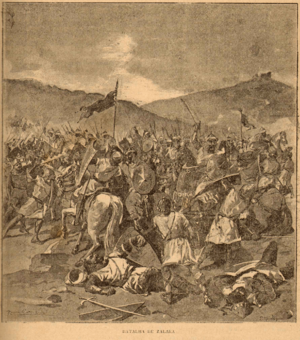Battle of Sagrajas facts for kids
Quick facts for kids Battle of Sagrajas |
|||||||
|---|---|---|---|---|---|---|---|
| Part of the Reconquista | |||||||
 Battle of Sagrajas |
|||||||
|
|||||||
| Belligerents | |||||||
| Commanders and leaders | |||||||
| Alfonso VI Álvar Fáñez Sancho Ramírez of Aragon |
|
||||||
| Strength | |||||||
|
2,500 60,000-80,000 |
Reportedly 3 times larger than Castilian army | ||||||
| Casualties and losses | |||||||
| Total destruction of the Christian force but 500 cavalrymen, who fled, survived |
3,000 Muslim sources state average casualties |
||||||
The Battle of Sagrajas (also called Zalaca or Zallaqa) happened on October 23, 1086. It was a big fight between the Almoravid army, led by their King Yusuf ibn Tashfin, and the army of the Castilian King Alfonso VI.
The Almoravids came to help the smaller Muslim kingdoms (called taifas) in Al-Andalus (parts of Spain and Portugal). These taifas usually fought among themselves. But they united to fight against the powerful Christian kingdoms to the north. The battleground was later called az-Zallaqah, which means "slippery ground" in Arabic. This name came from the huge amount of blood spilled during the battle.
Why the Battle Happened
After Alfonso VI, who was King of León and Castile, captured the city of Toledo in 1085, he also started attacking the taifa of Zaragoza. The leaders of the smaller Muslim kingdoms in Iberia realized they couldn't stop him on their own.
So, in 1086, they asked Yusuf ibn Tashfin for help. He was a powerful leader from North Africa. Yusuf agreed and brought his army across the sea to Algeciras. From there, he marched to Seville and then to Badajoz, gathering more Muslim leaders and their troops along the way.
King Alfonso VI stopped his attack on Zaragoza. He called back his soldiers from Valencia and asked Sancho I of Aragon for help. Alfonso then moved his army to meet the enemy northeast of Badajoz. The two large armies faced each other on October 23, 1086.
Alfonso VI arrived with about 2,500 men, including 1,500 horsemen. About 750 of these were knights. Even with these strong fighters, Alfonso's army was much smaller than the Muslim forces. Before the battle, the two leaders sent messages to each other. It is said that Yusuf ibn Tashfin offered Alfonso three choices: become a Muslim, pay a special tax (called jizyah), or fight. Alfonso chose to fight.
The Battle Begins
The battle started early in the morning on a Friday. The Castilian army attacked first. Yusuf ibn Tashfin had divided his army into three main groups.
The first group was led by Abbad III al-Mu'tamid, a Muslim leader from Seville. This group fought against Alfonso VI's army alone for most of the morning and early afternoon. Then, Yusuf ibn Tashfin and his second group joined the fight. They began to surround Alfonso VI and his soldiers.
Alfonso's troops started to panic and lose ground. At this point, Yusuf ordered his third group to attack. This group was made up of strong African warriors who fought with curved swords (called Talwars) and long spears (called javelins). Their attack helped to end the battle.
After the Battle
The battle was a big victory for the Almoravids. However, both sides suffered many losses. More than half of the Castilian army was lost. Some reports say that only about 500 horsemen managed to escape back to Castile. Many important leaders from the Christian side died in the battle. King Alfonso VI was hurt in one leg and walked with a limp for the rest of his life.
The Almoravid side also had many casualties, meaning many soldiers were killed or injured. The camp of Dawud ibn Aysa was attacked and looted early in the battle. The Emir of Badajoz, al-Mutawakkil ibn al-Aftas, also suffered heavy losses. The Sevillan Emir al-Mu'tamid was wounded early on, but his bravery helped to keep the Muslim forces fighting during the strong first attack by the Castilians.
Even though the Almoravids won, they had lost so many soldiers that they couldn't immediately continue their attack. Yusuf ibn Tashfin also had to return to Africa sooner than planned because his son, who was supposed to take over after him, had died.
Castile did not lose much land, and they managed to keep the important city of Toledo. However, this battle stopped the Christian advance for several generations. Both sides needed time to rebuild their armies and strength.
See also
 In Spanish: Batalla de Sagrajas para niños
In Spanish: Batalla de Sagrajas para niños

